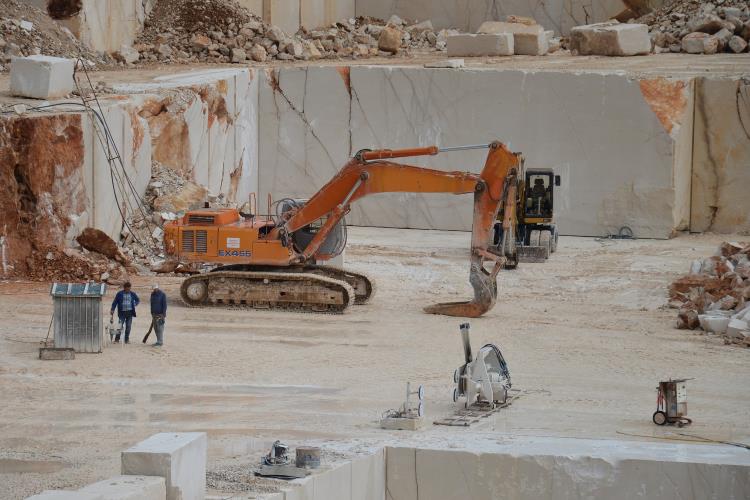
Merging Innovation and Contemporary Design
When it comes to unique design, the new Hinsdale residence in Illinois might be the best representative. This residence stretches over two stories and is formally nicknamed as the “Art House” since every room has some type of a natural stone that is the focal point. The materials used to structure the creation include:
- Wood that agrees with the granite tools and stone elements
- Steel for the support of heavy pieces
- Tile that matches the color-scheme of the natural elements
Once put together, this project was successful enough to win the “Residential Stone” award from the Coverings Installation and Design. Workforce needed to finalize the endeavor included over a dozen builders and professionals such as Teresa Fister, Jordan Homes, and Alma Flores. One year was needed to get the project from start to finish as well as many granite blades followed by a single quartzite blade.
Kitchen and the Dining Room
One of the most popping elements of the kitchen is the island bar. It is made from one piece of a very large Dalamata dolomite. This stone beautifully stretches over a large portion of the room and gives it an uncommon atmosphere with the white and black details called veins. The table is directly built into the island in form of a black granite top.
The builders somewhat separated the dining room from the kitchen with a minor wall made out of Patagonia White granite. This is where the quartzite blade came in handy. The wall echoes the color-scheme seen in the kitchen as it contains materials that are neutral in color. One interesting fact about this wall is the sheer weight of it that required over half-a-dozen professionals to put it in place. The dining room further contains a bar that brings additional elegance via White Shadow marble.
Bathroom
The scenery keeps up its unquestionable beauty as one moves to the master bathroom. Here, however, wood replaces some of the stone seen in the kitchen as it is not the most dominant piece anymore. Nevertheless, stone accompanies the wooden twin vanities that are separated by nothing else than a tub. The sinks on each side of the tub and the room window are topped with the white stone called Opal Calcite, while the bottom is made of easy-flowing wood.
Powder Room
This room presents the peak of the construction that took place. It brings back the black-white-gray scheme seen in the kitchen that was temporarily replaced by the wooden sensations in the master bathroom. Here, the builders went back to those darker stones such as the Calacatta Black marble that came from Italy. Tile options are the most dominant portion of this room as they arise all the way from the floor to the ceiling and reinforce the veins that are displayed on the black stone and shaped with granite blades.
Other Details
When moving around the home, through various hallways and rooms not mentioned here, there are many details that match the consistency of the construction. For example, the so-called waterfall-like edges are the very signature move of the architect who designed the place. The name of the builder is Blue Pearl, owned by Teresa Fister who was mentioned earlier.
Most of the mainstream popularity of this residence comes from the type of material and granite tools used. People rarely expect to see such a contemporary construction provide a warm environment where almost anyone can live. This is why the home has drawn attention from visitors far beyond the state of Illinois. Owners of the house, however, saw no problem with mixing the type of materials discussed here as they are experienced with arts and production of steel.
It seems that their risk paid off and the partnership with companies such as CVG Architects was more than fruitful. After all, winning the award for an outstanding design and installation of tile and stone, which is given by CID Awards, does not come easy!

Safe Product Handling Important For Profits
In today’s modern world, customer needs and wants continue to change, influenced by trends in design. Countertops become larger and custom requests become more common. For fabricators working directly with end customers and designer, there are more demands for custom and innovative designs than ever before. To keep up with these trends, stone fabricators must keep their offerings and tools current and relevant.
While design and timetables are important, concerns for safety in material handling and transportation remain important. In terms of the shop environment, tools and materials are evolving, changing and including safety features. Putting safety first is important and adds value to the product. Safety procedures pay off in lower costs to the fabricator, fewer operator accidents and injuries, more precise cuts and fabrications being completed in a timely manner.
Machine load capacities, simplified operation of mechanisms for both sling and strap applications and well designed and well-placed safety posts all combine to improve safety and have a positive impact on productivity and profitability. In addition, online safety and instruction videos along with other safety training materials are now virtually available easily. Internet-based training materials and videos are easily available to all and fill a need for understanding basic manufacturing concepts and safety standards.
While safety is the first and primary concern in using granite tools, granite blades and quartzite blades, safe operations will increase the profitability and productivity of an individual worker and a fabricating facility. Time in processing can be reduced, along with expenses of manufacturing, with enhanced safety practices. The safe and economical process of prepping, cutting, finishing, storing and transporting finished goods is impacted.
Let’s trace an average job through the fabrication process. Careful work processes and procedures reduce waste of material and time while adding value to the finished product. This starts with the receipt of a truckload of stone slabs at the doc. After unloading, the slabs are held for inspection, usually away from the area s dock area. Once inspected and selected for a project, the slab must be cut. This requires that the slab is moved to a work table for layout and the actual cutting. Then the stone is moved to the fabricating and polishing area of the shop. When that work is finished, the piece or pieces are moved again to prep for shipment and transported to the customer’s location.
This process means that it is possible for a slab to make several movements through the shop. Every fabricator knows that every time you move or stage a slab for processing, it simply increases the chance of damage to the slab. Not only are there opportunities for safety issues to occur, the constant moving of slab adds time to the process and could possibly move out the estimated delivery time to the customer.
Now that we know that safety is important and contribute to the cost of manufacturing, we can look at the process of handling, finishing and storing the stone slabs. Simplifying and streamlining the process can improve safety, reduce manufacturing time and decrease costs. The best way to look at this process overall is to simply diagram the movements.
Diagramming the movements starts with a sketch of the work area. The movements are marked on the diagram and every required stop for handling, cutting and finishing process is noted. This diagram may well end up looking like a scribble or an abstract design, but it can be very useful. When you look at it, you often can see where the workflow may have double backed on itself or simply gone around in circle. Simplifying the work process can be an improvement in itself, increasing safety, reducing costs and improving your profit margin.
When you can improve the process and its flow, you will be improving the quality of the finished product and the profit margin on the production. Reducing the number of times you handle a project simply reduced the opportunity for damage to the stone or an accident for the fabricator.
In summary, the profitability of your business of manufacturing stone slabs for the consumer is more than just having the best granite tools available. It’s more than having the most efficient granite blades or quartzite blades. It’s a combination of the right tools, efficient processes and attention to safety issues.


